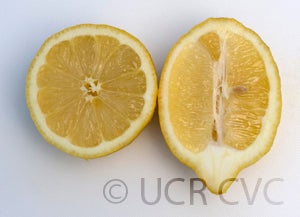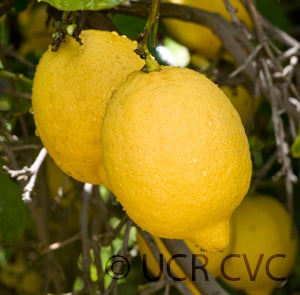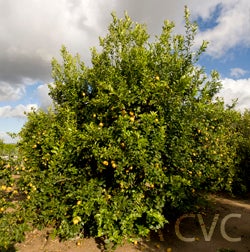Citrus limon L. Burm.f.
CRC 390
PI 600625
Source
Received as budwood from a grove in Glendora, Calif., 1914.
Parentage/origins
Said to be of Sicilian origin.
Rootstocks of accession
Yuma Ponderosa lemon.
Season of ripeness at Riverside
Fruit indistinguishable from Eureka, but seasonal distribution of crop more like Lisbon, mainly in winter.
Notes and observations
Buds cut from famous tree, having heaviest yield on record (1250 lb. fruit in one year). Tree in unpruned grove at Glendora. Yield records taken and kept by Mr. Hosford of San Dimas Lemon Assoc. 4/07/1914. Buds cut by Mertz, Barrett, and Milliken, San Dimas, Calif.
Description from The Citrus Industry Vol. 1 (1967)
"Fruit indistinguishable from Eureka, but seasonal distribution of crop more like Lisbon, mainly in winter.
Tree similar to Lisbon, but more open and less upright in growth habit, less thorny, and not as densely foliated.
These characterizations are adapted from Webber (1943), since the original clone has been little propagated commercially in California, or elsewhere so far as can be ascertained, for many of decades. Indeed, Villafranca is currently of so little importance as scarcely to warrant inclusion here. The only reason for including it lies in the fact that certain clones with characteristics intermediate between Eureka and Lisbon have been propagated as selections of those varieties. Almost certainly several of those currently of importance in California—notably the so-called Galligan Lisbon and Corona Foothill Eureka selections—are in reality Villafranca selections. This may conceivably be true also of the popular so-called Rosenberger Lisbon and Ross Eureka selections.
Said to be of Sicilian origin, the Villafranca variety was introduced into Florida by H. S. Sanford about 1875 and brought to California not long thereafter."
Availability
Not commercially available in California.
USDA Germplasm Resources Information Network page for Villafranca lemon CRC 390


